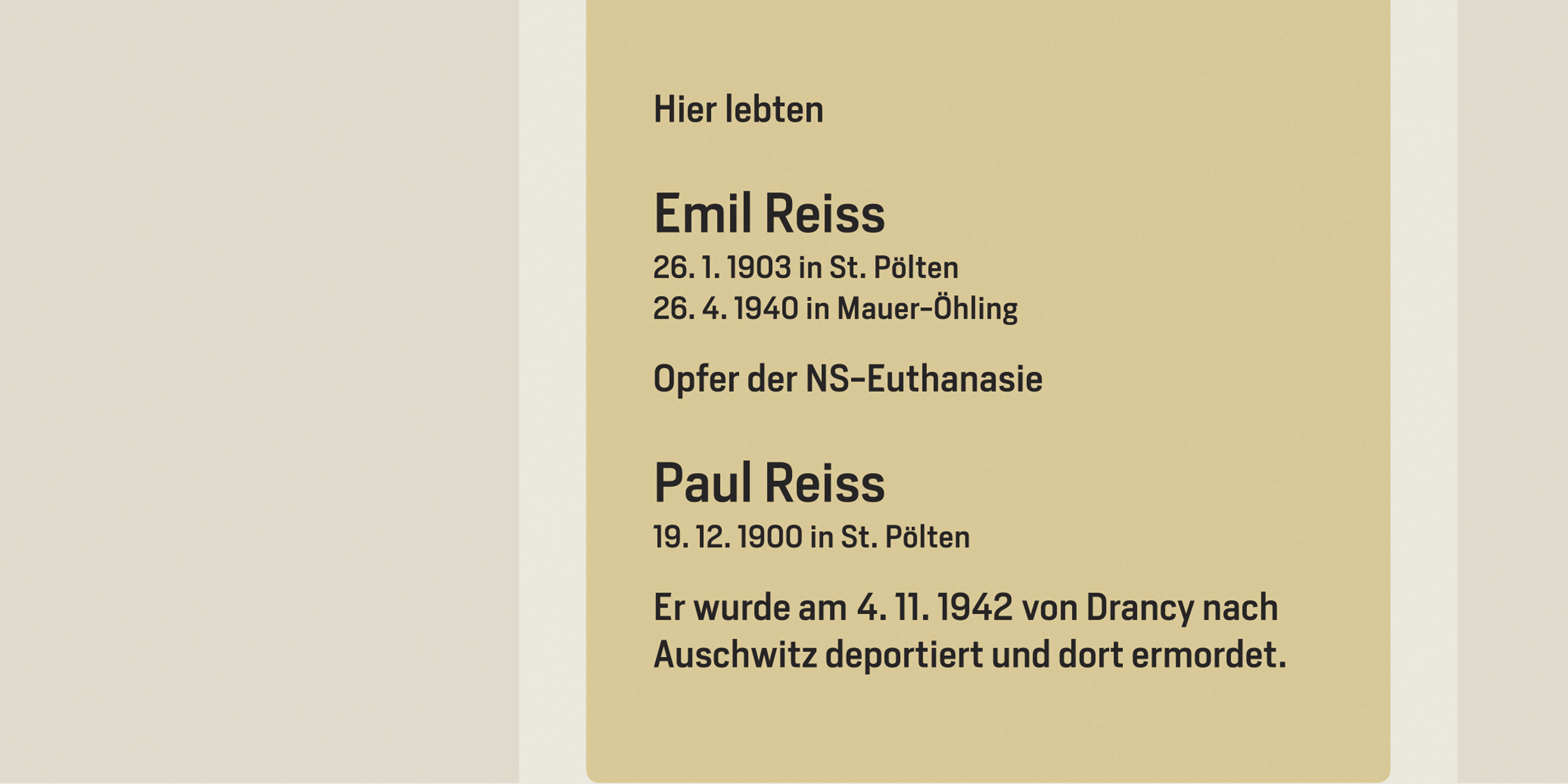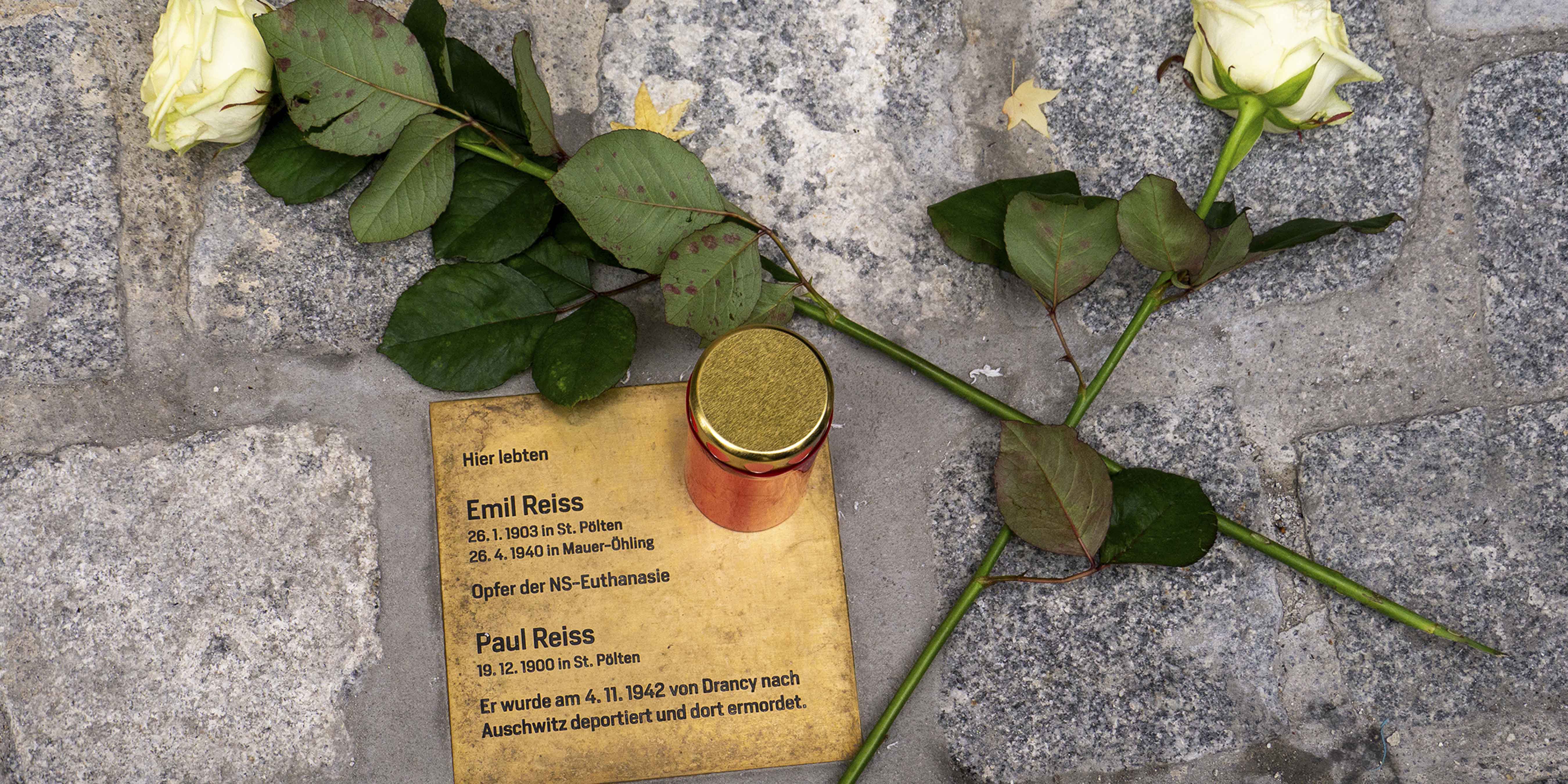Steine der Erinnerung


Paul Reiss
Paul Reiss, geboren am 19. Dezember 1900 als Sohn des Kaufmanns Moritz Reiss und dessen Frau Emma, geb. Kolb, war erst 15 Jahre alt, als er seinen Vater verlor. Moritz’ Grabstein am jüdischen Friedhof in St. Pölten ist noch erhalten: „Hier ruht unser unvergesslicher guter Gatte und Vater Moritz Reiss, geb. am 13. Februar 1868, gest. am 18. April 1915, tief betrauert von seiner Gattin und seinen Kindern.“
Insgesamt hatten Moritz und Emma fünf Kinder: Charlotte verstarb als Kleinkind, Rosa, geboren 1897, konnte mit ihrer Mutter und ihrem Mann Ernst Schulhof im Mai 1939 nach Shanghai fliehen, wo Emma am 24. März 1943 verstarb. Rosa ließ sich mit Mann und Töchtern 1947 in Melbourne nieder und starb dort 1951. Ihre Schwester Elly Elsa, 1898 geboren, lebte mit ihrem Mann Karl Weihrauch in Wien. Sie wurde auf der Flucht über die Schweiz nach Frankreich in Nizza verhaftet und am 3. Februar 1944 von Drancy nach Auschwitz deportiert. Auch Pauls Schicksalsweg führte von Drancy nach Auschwitz, er wurde auf der Flucht nach Belgien verhaftet und in Frankreich inhaftiert. Seine Deportation aus dem Durchgangslager Drancy in das Vernichtungslager Auschwitz erfolgte am 4. November 1942. Das 1932–34 ursprünglich als Großwohnanlage errichtete Gefangenenlager Drancy, 20 km nordöstlich von Paris, stand ab der Besetzung Frankreichs im Juni 1940 als Sammel- und Durchgangslager unter der Aufsicht der Deutschen Wehrmacht und SS. Von hier wurden mindestens 65.000 mehrheitlich französische Jüdinnen und Juden in die Vernichtungslager deportiert. Die Todestage von Paul und seiner Schwester Elly sind nicht bekannt. Pauls jüngerer Bruder Emil wurde in der „Landes-, Heil- und Pflegeanstalt Mauer-Öhling” ermordet.
Paul Reiss and his brother Emil
Paul Reiss
Paul Reiss, born 19 December 1900 to the merchant Moritz Reiss and his wife Emma, née Kolb, was only 15 years old when he lost his father. Moritz’s grave stone still stands in the Jewish cemetery of St. Pölten: “Here rests our unfor gettable good husband and father, Moritz Weiss, born 13 February 1868, died 18 April 1915, mourned deeply by his wife and his children.”
Moritz and Emma had altogether five children: Charlotte died as an infant, while Rosa (born 1897) was able to flee to Shanghai with her mother and her husband Ernst Schulhof in May 1939, where Emma died on 24 March 1943. Rosa settled in Melbourne with her husband and daughters in 1947, where she died in 1951. Her sister Elly Elsa (born 1898) lived in Vienna with her husband Karl Weihrauch. She was arrested in Nice after having fled to France via Switzerland and was deported from Drancy to Auschwitz on 3 February 1944.
Paul’s fate also led him from Drancy to Auschwitz, having been arrested in Bel gium and interned in France. His deportation from the Drancy transit camp to the Auschwitz extermination camp took place on 4 November 1942. The infa mous detention camp in Drancy, originally established as a municipal building complex in 1932–34 some 20 kilometers northeast of Paris, was run as a collection and transit camp by the German Wehrmacht and SS following the occupa tion of France in June 1940. At least 65,000 predominantly French Jews were deported to the extermination camps from here. The dates of death of Paul and his sister Elly are unknown.
Emil Reiss
“13.9.38: During the night, the patient tore up 1 shirt, 1 bedsheet, 1 straight- jacket, and 1 pillowcase, claiming he was upset because of how the Jews are being treated and because he has no hope left of being released from his cot.” (Patient file of Emil Reiss from Mauer-Öhling, NÖLA)
Emil Reiss, Paul’s younger brother, was born on 26 January 1903. In 1921, he was diagnosed with “congenital imbecility” and admitted to the “Regional Sana torium and Mental Hospital” MauerÖhling near Amstetten in Lower Austria. His patient files reveal, however, that he was competent enough to protest against his maltreatment and the generally bad conditions in the institution as well as to realistically assess the political situation. It is probably no coincidence that his aggressive behavior increased after the “Anschluss” and he was forced to spend weeks at a time in a straightjacket and confined to his cot. On 5 June 1939, he stated that the cause for his disquiet was the fact that he had heard nothing from his relatives – he presumably did not know yet that his mother and sister had fled with the latter’s family to Shanghai on 29 May. According to an entry dated 22 September, he frequently asked “what will happen to the Jews, whether they will have to emigrate”. His “destructive mania”, which was diagnosed as a symptom of illness, was to be a foreshadowing of the coming mass murder.
Emil Reiss passed away on 26 April 1940, with the official cause of death cited as pulmonary tuberculosis and an abscess in the lower vertebra of the chest. However, his patient file also records a sharp reduction in weight, although “the patient eats all the food given to him”. It may therefore be assumed that he, like most of his fellow sufferers, was not sufficiently fed. Emil was one of at least 2800 victims of Nazi “euthanasia” at MauerÖhling. Altogether 200,000 “men tally handicapped people” were murdered in Nazi Germany, including 30,000 in what was then the “Ostmark”.